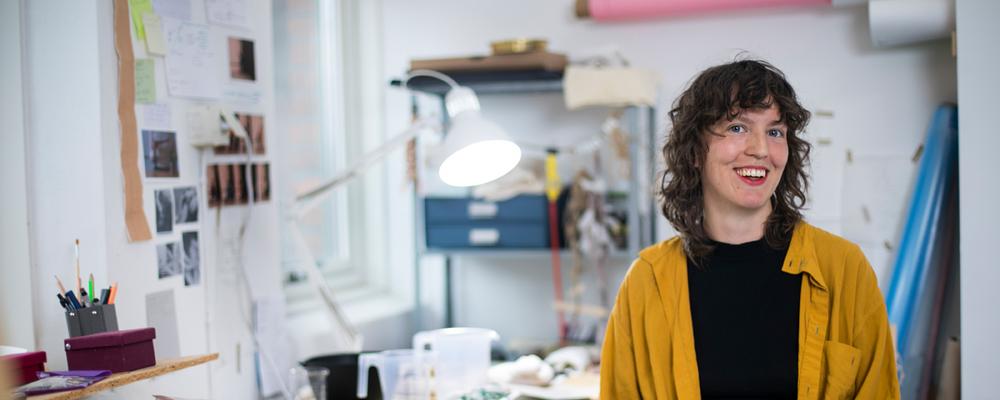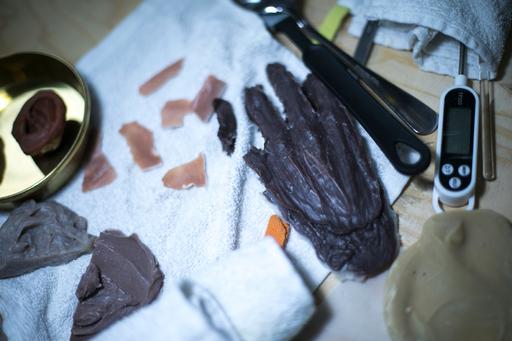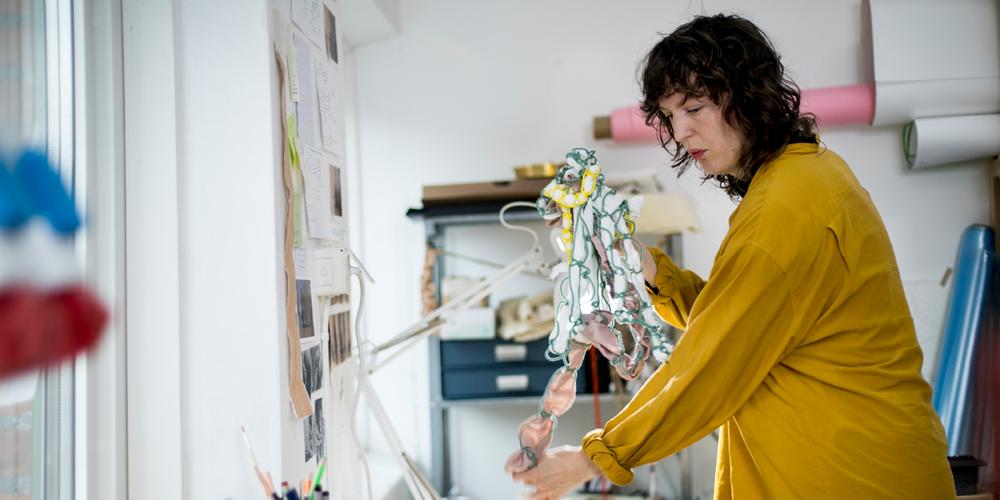
- Home
- News and events
- Find news
- At HDK-Valand, the Camera Became Åsa’s Way of Thinking
At HDK-Valand, the Camera Became Åsa’s Way of Thinking
Åsa Båve has run a filmmaking collective, earned a Bachelor's degree in photography, and at present is working with sculpture. But regardless of which art form she chooses, her tool is the camera. Three years after graduating from HDK-Valand, she has a studio at Klippan, has received multiple grants, and has built up a daily routine for herself as a working artist.
On the top floor of a building that was once a sugar mill lies Åsa Båve’s studio. The peak of the roof is several metres overhead, and on a table by the window lie some sculpted hands with forms that are both fragile and sharp. Åsa is mixing paint with soap in a bucket, and explains that she has been using soap as a material in her latest projects.
“I’ve been exploring a theme related to care and treatment, which I often come back to. It’s about the immeasurable aspect of care, the part that’s based on interpersonal relationships, and how it fits into the health care industry’s ubiquitous focus on time and the constant attempt to measure everything."
Film or fine art turned into photography
She works with sculptures in which various health care materials play a role. Sculpture is a relatively new passion in Åsa’s life. Her foremost tool has always been the camera, and two years ago she earned a bachelor’s degree in photography at HDK-Valand.
“It was during that programme I found my relationship to the camera,” she says, “and regardless of whether I’m sculpting or doing something else, it has become part of my way of thinking.”

Focusing on photography, however, was not her original plan when she began applying to art schools. With her background in a film collective and a year-long project in the Gothenburg School of Art’s Artistic Concept Realisation programme, Åsa was intent at that time on getting into an educational programme in film or fine art. But after going through a period of applying to multiple programmes, her plan changed.
“In the application interviews for fine art programmes, I was told I ought to apply to film, and in the film interviews I was told I ought to apply to fine art,” she says. “That made me think. In the end I decided that photography is somewhere in between the two. I made one last attempt to get in.”
Planning is essential for a freelance artist
It is now almost three years since Åsa graduated from HDK-Valand, and during that time she has established a daily routine for herself as a working artist. She has been awarded several grants and spent time in Iceland as an artist in residence. A part-time job teaching film at a community college creates financial stability.
But perhaps the most important piece of the puzzle for getting everyday life as an artist to work, she believes, is to plan your time and structure your work according to administrative as well as artistic and personal requirements.
“To make a go of it as a freelance artist, I believe you have to figure out how you yourself work and then plan accordingly – so that your energy, desire and money don’t run out. For example, my teaching job brings me inspiration rather than sapping my energy, and I devote time in the mornings to grant applications, email and record-keeping in order to create longer stretches of uninterrupted time in the studio in the afternoon, which is when I do my best work."

Åsa wishes that the curriculum at HDK-Valand had prepared her better for life as an artist. At the same time, she appreciates the opportunity it gave her for in-depth study.
“It was fantastic to be given a three-year sanctuary in which I didn’t have to think about the responsibilities inherent in everyday life and I could just focus on my creating,” she says. “The organisation of the curriculum, which weaves together theory and practice, taught me to do research and find references, and it shaped my way of working. I also learned to articulate my thinking about my art, which I now use in applying for grants.”
The education became a stroke of luck
Back in the old sugar mill, Åsa is stirring her soap bucket. The contents are starting to take on the hue of sponge cake batter. There are seven different workstations here, along with a shared studio space and a break room. The interaction with the other artists she shares the studio with is important to her. She sometimes misses her time in the film collective and appreciates the intimate exchange of ideas with others.
“Learning to work alone has been a journey,” she says. “I now enjoy being able to work wordlessly and test things without having to be clear in my thinking first. You can let yourself be more vulnerable in the process when you don’t have to be accountable to the others in a group.”

Åsa is happy in her studio, and confides that she’s in a good place right now. And not just physically: what started as kind of a gamble – her focus on photography – has turned out to be exactly what she needed. During her time at HDK-Valand, she discovered that photography’s distinctive attributes match the questions that have always captured her interest.
“Photography’s ability to freeze a moment, to lift a situation out of its context and transport it to someplace else, to be able to work with time in different ways – I’ll never stop being fascinated by it. It’s everything.”
By Åsa Rehnström
